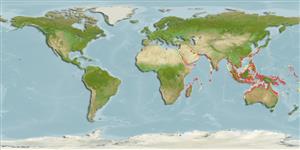>
Beloniformes (Needle fishes) >
Belonidae (Needlefishes)
Etymology: Strongylura: Greek, strongylos = round + Greek, oura = tail (Ref. 45335).
Environment: milieu / climate zone / depth range / distribution range
Ökologie
seewasser; brackwasser; tiefenbereich 5 - 25 m (Ref. 122660). Tropical; 30°N - 27°S
Indo-West Pacific: Persian Gulf eastward along the coasts of Pakistan, India, and Sri Lanka, then extending to southern China, the Philippines, and northern Australia. A record from Zanzibar (Tanzania) needs confirmation.
Size / Gewicht / Alter
Maturity: Lm ? range ? - ? cm
Max length : 40.0 cm SL Männchen/unbestimmt; (Ref. 4833); common length : 22.0 cm SL Männchen/unbestimmt; (Ref. 9682)
Rückenflossenstacheln (insgesamt) : 0; Rückenflossenweichstrahlen (insgesamt) : 12 - 15; Afterflossenstacheln: 0; Afterflossenweichstrahlen: 15 - 18; Wirbelzahl: 59 - 65. Round in cross section. Dorsal fin rays 12-15; anal fin rays 15-18. Caudal peduncle without lateral keels. Caudal fin rounded or truncate. Predorsal scales few and relatively large, 100-130. Caudal fin light with a prominent round black spot near its base. Dorsal fin lobe and distal margin of caudal fin yellow in live adults, anterior margin of anal fin orange.
Found in coastal areas and mangrove-lined lagoons, also enters freshwater. Carnivorous. Feeds mainly on small fishes, especially clupeoids. Occurs at temperatures ranging from 26 to 29°C (Ref. 4959). Oviparous (Ref. 205). Eggs may be found attached to objects in the water by tendrils on the egg's surface (Ref. 205). Sold fresh in markets.
Life cycle and mating behavior
Geschlechtsreife | Fortpflanzung | Ablaichen | Eier | Fecundity | Larven
Collette, B.B., 1984. Belonidae. In W. Fischer and G. Bianchi (eds.) FAO species identification sheets for fishery purposes. Western Indian Ocean (Fishing Area 51), Volume 1. FAO, Rome. (Ref. 3130)
IUCN Rote Liste Status (Ref. 130435: Version 2024-1)
Bedrohung für Menschen
Harmless
Nutzung durch Menschen
Fischereien: kommerziell
Tools
Zusatzinformationen
Download XML
Internet Quellen
Estimates based on models
Preferred temperature (Ref.
123201): 25.1 - 29.2, mean 28.5 °C (based on 2807 cells).
Phylogenetic diversity index (Ref.
82804): PD
50 = 0.5001 [Uniqueness, from 0.5 = low to 2.0 = high].
Bayesian length-weight: a=0.00102 (0.00055 - 0.00192), b=3.09 (2.93 - 3.25), in cm total length, based on LWR estimates for this species & Genus-body shape (Ref.
93245).
Trophic level (Ref.
69278): 4.2 ±0.73 se; based on food items.
Widerstandsfähigkeit (Ref.
120179): hoch, Verdopplung der Population dauert weniger als 15 Monate. (Preliminary K or Fecundity.).
Fishing Vulnerability (Ref.
59153): Moderate vulnerability (39 of 100).
